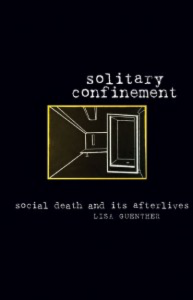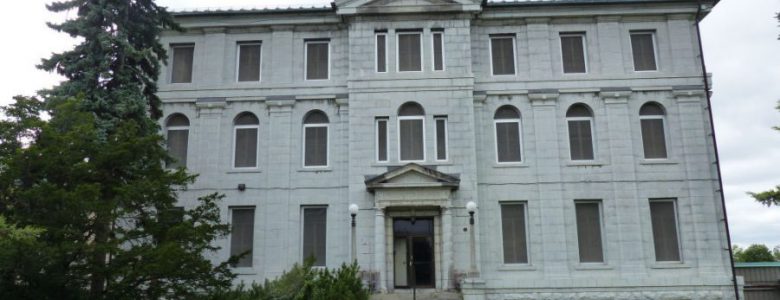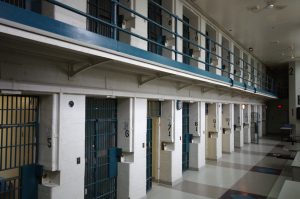The Kingston Prison for Women in Kingston, Ontario, Canada (photo from Wikimedia Commons)
In the first of a two-part series, philosopher Lisa Guenther introduces the Prison for Women in Kingston, Ontario and how its history – as the former home of hundreds of incarcerated women, and the site of unethical human experiments and other forms of prisoner abuse— is woven into the civic life of Kingston, raising challenging questions about the future of the property.
What is to be done with sites of state violence and psychiatric abuse? Should these places be set apart from everyday life as monuments to the past, reminders for the present, and warnings for the future? Should they be turned into museums for public education or archives for scholarly research? Or should they be reclaimed, transformed, and redeveloped according to the needs and desires of the community? And if so, who gets to speak for “the community”?
These are not abstract questions for Kingston, Ontario, the small city where I live and teach philosophy at Queen’s University, Canada. Kingston has the highest concentration of prisons in Canada, and it is home to the nation’s first penitentiary, founded in 1835, and the first Prison for Women, founded in 1934. Both prisons are now closed and slated for redevelopment.
Kingston Penitentiary (KP) closed in 2013, and it is now the site of prison tours run by the St. Lawrence Parks Commission, often with former guards as tour guides. Redevelopment plans for the site include a 500-unit condominium, restaurants, retail, and a sailing club; it is favourably situated on the shores of Lake Ontario, near the Portsmouth Olympic Harbour (link).
The Prison for Women (P4W) closed in 2000, following an inquiry into a 1994 incident where an all-male Institutional Emergency Response Team (IERT) strip-searched women prisoners who were protesting in the wake of a string of suicides that took the lives of seven women, six of whom were Indigenous. There is no mention of any of this in the Penitentiary Museum, which is housed in the former warden’s residence adjacent to P4W and across the street from KP. There is, however, a full-wall display honouring the Institutional Emergency Response Team, featuring a mannequin dressed in full riot gear and a photograph of IERT members in uniform, holding rifles and smiling for the camera.
In 2007, Queen’s University purchased P4W, intending to house the university archives in the historic cell block. But after years of neglect, the building was full of black mold, and it would take a considerable investment to make it fit for use. The prison sat empty for over ten years until June 2018, when a commercial developer named ABNA Investments purchased the prison and the eight acres of land on which it stands. Possible uses include condos, student housing, and a hotel (link).
Hank Doornekamp, owner of ABNA Investments, told CBC news: “It’s a beautiful building. We’re going to take off the appendages that have been added that don’t belong to it, and we’re going to restore it back to its original [state]” (link). The developer also wants to remove the heritage designation from interior elements such as steel bars and locking mechanisms: precisely the features that define its history as a prison.
But not everyone thinks P4W is beautiful. Already in 1934, the Archambault Report recommended its closure due to “disgraceful” conditions (link). More than forty years later, the MacGuigan Report called for the closure of P4W once again, declaring the prison “unfit for bears, much less for women” (link).Still, the prison remained open. For almost 70 years, any woman who received a sentence of two years or more in Canada would be shipped to P4W, whether her family and support systems were in the Yukon Territory, in Newfoundland, or anywhere in between.
One of the most egregious examples of abuse at the prison took place in the late 1950s and early 1960s, when experiments with LSD and electroconvulsive therapy were conducted on women at P4W. Dorothy Proctor was one of 23 prisoners who were given LSD as part of a 1961 study conducted by Dr. Mark Eveson, a graduate of Queen’s University, under the supervision of Dr. George Scott, the prison’s head of psychiatry. Due to missing or destroyed records, only four of the other 23 women have been identified (link).
One of the most egregious examples of abuse at the prison took place in the late 1950s and early 1960s, when experiments with LSD and electroconvulsive therapy were conducted on women at P4W.
Dorothy Proctor was arrested in 1960 and sentenced to three years at P4W for auto theft. She was just 17 years old. As a mixed-race woman of African and Mi’kmaq descent and a survivor of sexual abuse, Proctor struggled against racism, settler colonialism, sexism, and sexual violence from a very early age. At P4W, she was regularly punished with solitary confinement for “defiance” or “abusive and indecent language” (link).
In solitary, Proctor says, “I thought I was going to die… I never thought of a future, because right then and there, there was just absolutely no future, there was no future to think about” (link). As I have argued elsewhere (link), solitary confinement is a form of touchless torture. By isolating a person from others and blocking their participation in a shared world with open-ended horizons, prolonged solitary confinement attacks the very structure of personhood as a Being-in-the-world and a Being-with Others. At P4W, Proctor was isolated in a “dry cell” with no toilet and no running water, just a filthy hole in the middle of the floor.
It was during one of these periods of disciplinary segregation that Dr. Eveson approached Proctor, offering her a way out of solitary if she participated in a research project. In an interview with CBC radio, Proctor reflects, “Now I know that I was being primed with sensory deprivation to prepare me for the other experiments. At that time I didn’t know, I was just told it was for disciplinary reasons” (link).
Proctor reflects, “Now I know that I was being primed with sensory deprivation to prepare me for the other experiments. At that time I didn’t know, I was just told it was for disciplinary reasons.”
Dr. Eveson gave Proctor her first hit of LSD in 1961: five blue pills, or 200 milligrams. Proctor recalls, “I don’t think it was 15, 20 minutes later before I had experienced the inferno. What’s his name, Dante’s inferno. I mean it was, obviously I can’t get out, I can’t run away, I’m locked in a cell and the walls start to move in towards me and melt. The bars turn to snakes, there was an awful physical vibration in my body. It was just awful, it was just awful” (link).
Proctor remembers at least 10 LSD sessions with Dr. Eveson, as well as numerous electroshock therapy sessions, during her incarceration at P4W, but due to incomplete records, direct evidence has only been located for four sessions. No written consent was obtained from Proctor or the other prisoners subject to experimentation.
Proctor continues, “I was a nothing, I was just something to experiment on. They probably discussed it among themselves but it was never discussed with me, I was not worthy of that respect” (link). In another interview, she says that from the perspective of prison doctors, “I was just a biological unit” (link). This reduction of a complex Being-in-the-world to a captive biological unit informs other notorious experiments on prisoners, including dermatological research at Holmesburg Prison in Philadelphia (link) and behavior modification programs at Marion Federal Penitentiary, which explicitly targeted politically-active prisoners (link). And it continues to drive pseudo-scientific research into the biological basis of “criminality” (link).
In 1998, Dorothy Proctor sued Corrections Service Canada for psychiatric abuse at P4W, and in 2002, they settled the case out of court (link). According to Proctor, the settlement did not even cover her legal bills (link).
The abuse that exploited her feeling of “no future” in the early 1960s continued to haunt Proctor for decades:
I have flashbacks, I have, I have to live alert 24 hours a day. Like most people just sort of can take their days and their movements and their actions for granted, I can’t, I’m always, I’m always making sure that I’m stepping the right way, I’m doing, but it’s not noticeable to anyone who is watching me. It’s something that I’ve learned to live with and I handle. I don’t go into deep sleeps. I’ve been drug free for 11 years and it took me about the first five years before I could get some clarity and understand what was wrong with me. These are things that will live with me forever. (link)
Dorothy Proctor carries her experience of P4W everywhere she goes. But does P4W carry the memory of Dorothy Proctor? And who will remember the twenty-two other women who were also treated as lab rats and biological units by prison doctors at P4W, but whose records have been lost or destroyed?
Advocates for the commercial development of the former Prison for Women seem keen to put the unsavory past of incarceration, psychiatric abuse, state violence, and suicide behind them. But the economic life of this city has been fueled by prison industries for almost two hundred years. Not only has the confinement of men and women paid the wages of many Kingston residents, but the very stuff of the city – from the hand-worked limestone masonry of P4W to the hollowed-out field of the Queen’s football stadium – was built by convicted laborers.
What happens to the memory and the materiality of the city when we treat former prisons as “heritage buildings” and forget the life stories of people like Dorothy Proctor in orderto pave the way for development (link)? And how is this drive for development still haunted by the history of punishment and abuse that it tries to repress?
I will take up these questions in my next blog post on the past and future of the Kingston Prison for Women.

Lisa Guenther is Queen’s National Scholar in Political Philosophy and Critical Prison Studies at Queen’s University in Kingston, Ontario. She is the author of Solitary Confinement: Social Death and its Afterlives (2013) and The Gift of the Other: Levinas and the Politics of Reproduction(2007), and co-editor of Death and Other Penalties: Philosophy in a Time of Mass Incarceration (2015) with Geoffrey Adelsberg and Scott Zeman. She is currently working on a book about incarceration, reproductive politics, and settler colonialism in Canada, Australia, and the United States. As a public philosopher, Guenther’s work has appeared in The New York Times, The Chronicle of Higher Education, Aeon, and CBC’s Ideas.





